Cultural Dimensions & Social Media Use
VerifiedAdded on 2020/06/05
|14
|4556
|156
AI Summary
This assignment examines the relationship between national cultural dimensions and social media adoption rates and usage patterns. It utilizes Hofstede's six-dimensional cultural framework and explores how personality traits, as defined by the Big Five model, contribute to these differences. The analysis delves into various aspects of social media behavior, considering factors like communication styles, self-presentation, and privacy preferences within different cultural contexts.
Contribute Materials
Your contribution can guide someone’s learning journey. Share your
documents today.
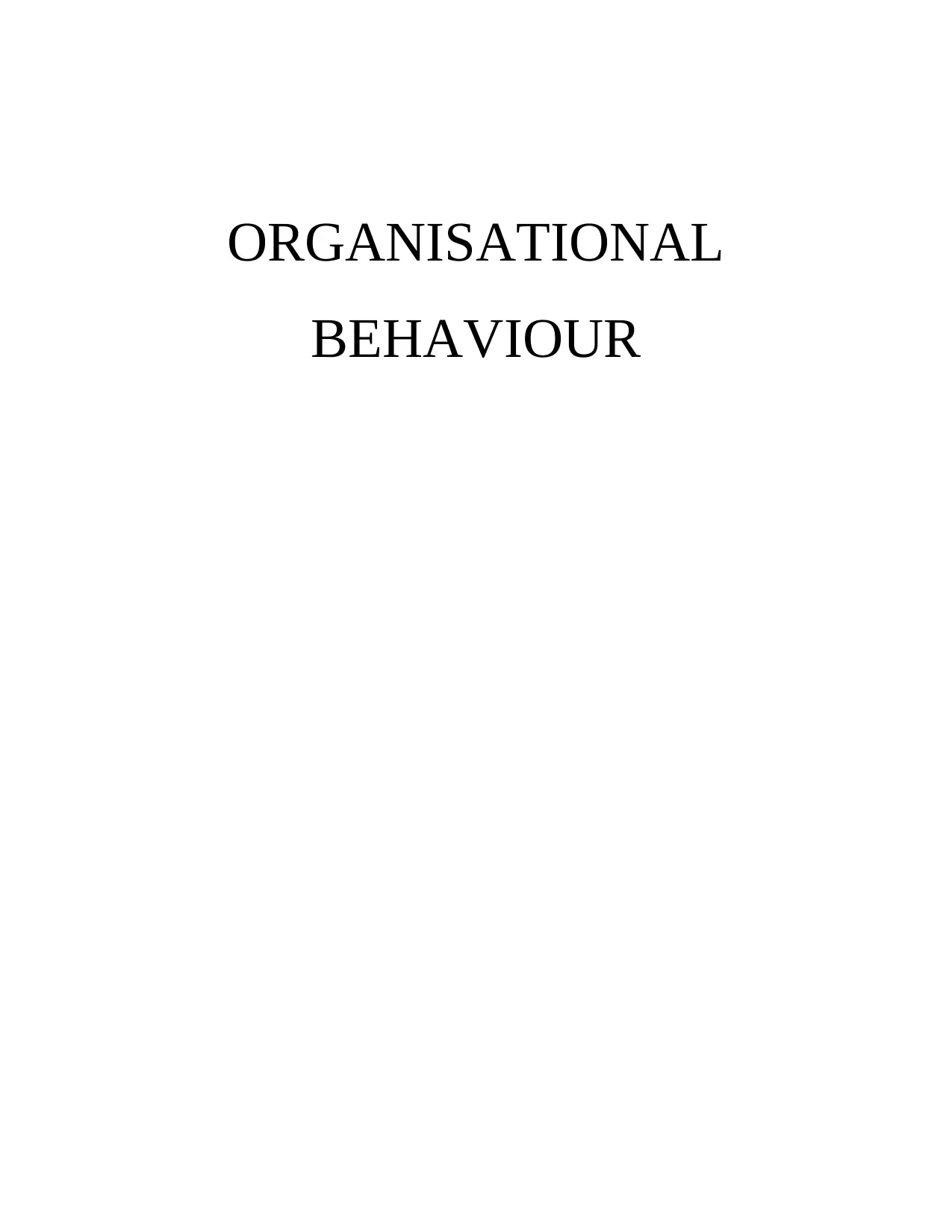
ORGANISATIONAL
BEHAVIOUR
BEHAVIOUR
Secure Best Marks with AI Grader
Need help grading? Try our AI Grader for instant feedback on your assignments.
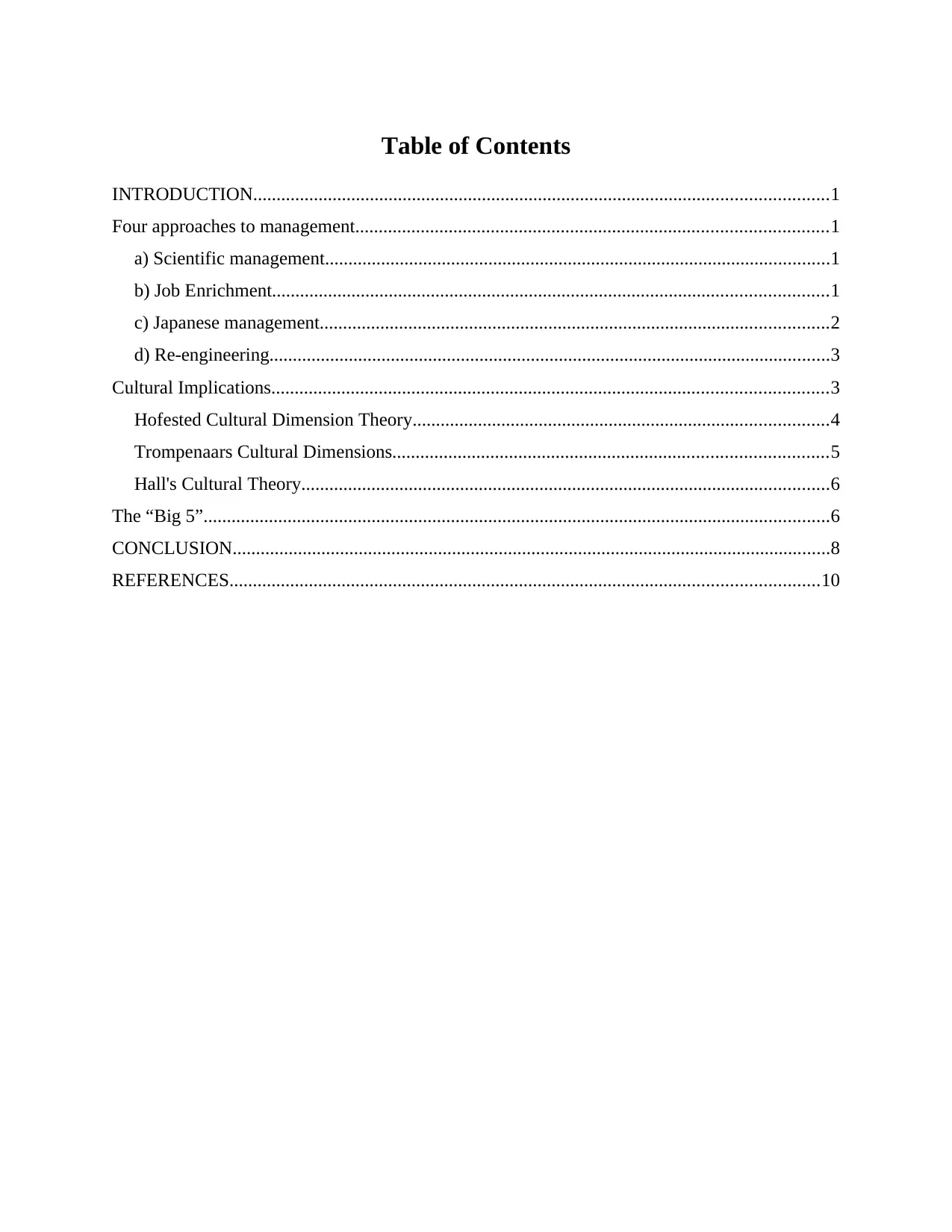
Table of Contents
INTRODUCTION...........................................................................................................................1
Four approaches to management.....................................................................................................1
a) Scientific management............................................................................................................1
b) Job Enrichment.......................................................................................................................1
c) Japanese management.............................................................................................................2
d) Re-engineering........................................................................................................................3
Cultural Implications.......................................................................................................................3
Hofested Cultural Dimension Theory.........................................................................................4
Trompenaars Cultural Dimensions.............................................................................................5
Hall's Cultural Theory.................................................................................................................6
The “Big 5”......................................................................................................................................6
CONCLUSION................................................................................................................................8
REFERENCES..............................................................................................................................10
INTRODUCTION...........................................................................................................................1
Four approaches to management.....................................................................................................1
a) Scientific management............................................................................................................1
b) Job Enrichment.......................................................................................................................1
c) Japanese management.............................................................................................................2
d) Re-engineering........................................................................................................................3
Cultural Implications.......................................................................................................................3
Hofested Cultural Dimension Theory.........................................................................................4
Trompenaars Cultural Dimensions.............................................................................................5
Hall's Cultural Theory.................................................................................................................6
The “Big 5”......................................................................................................................................6
CONCLUSION................................................................................................................................8
REFERENCES..............................................................................................................................10
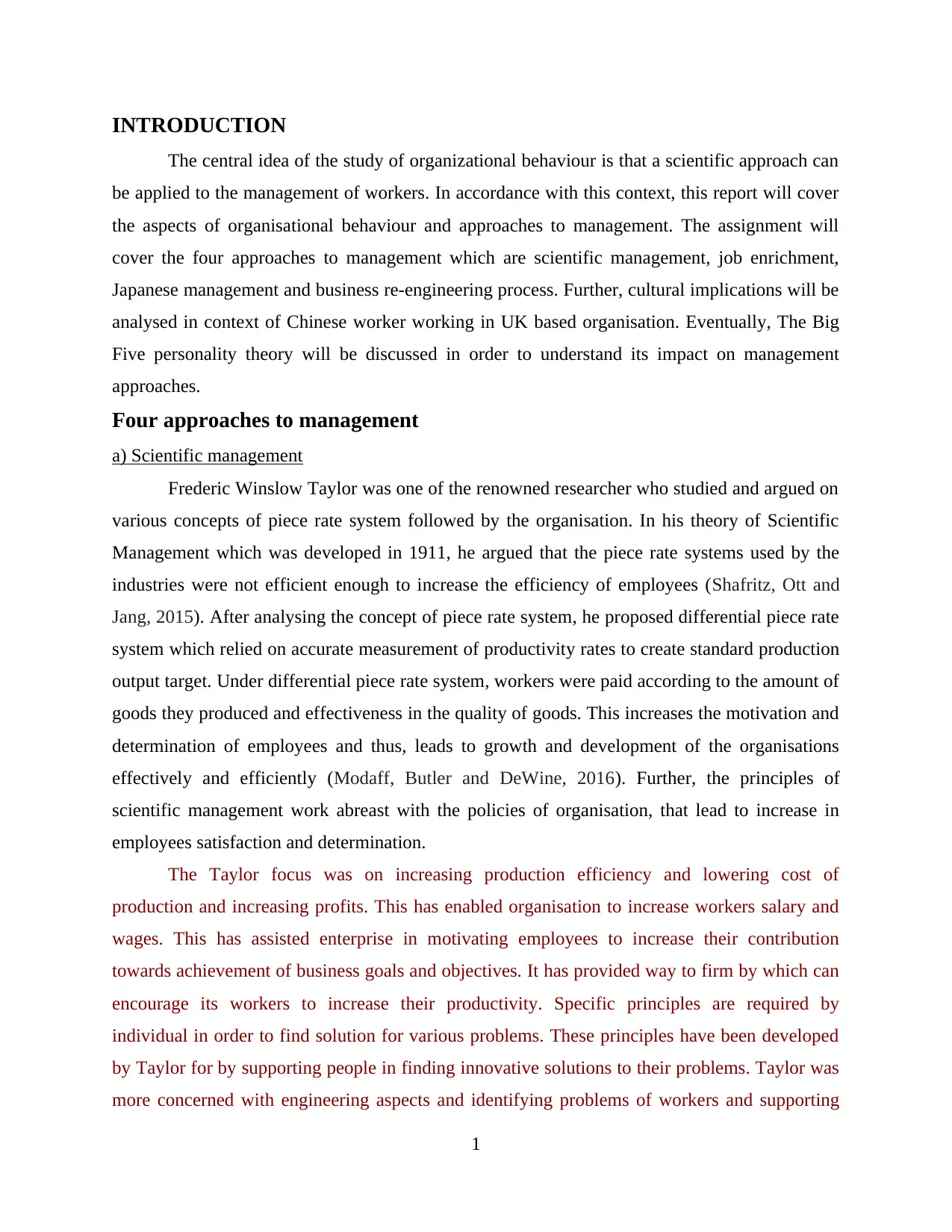
INTRODUCTION
The central idea of the study of organizational behaviour is that a scientific approach can
be applied to the management of workers. In accordance with this context, this report will cover
the aspects of organisational behaviour and approaches to management. The assignment will
cover the four approaches to management which are scientific management, job enrichment,
Japanese management and business re-engineering process. Further, cultural implications will be
analysed in context of Chinese worker working in UK based organisation. Eventually, The Big
Five personality theory will be discussed in order to understand its impact on management
approaches.
Four approaches to management
a) Scientific management
Frederic Winslow Taylor was one of the renowned researcher who studied and argued on
various concepts of piece rate system followed by the organisation. In his theory of Scientific
Management which was developed in 1911, he argued that the piece rate systems used by the
industries were not efficient enough to increase the efficiency of employees (Shafritz, Ott and
Jang, 2015). After analysing the concept of piece rate system, he proposed differential piece rate
system which relied on accurate measurement of productivity rates to create standard production
output target. Under differential piece rate system, workers were paid according to the amount of
goods they produced and effectiveness in the quality of goods. This increases the motivation and
determination of employees and thus, leads to growth and development of the organisations
effectively and efficiently (Modaff, Butler and DeWine, 2016). Further, the principles of
scientific management work abreast with the policies of organisation, that lead to increase in
employees satisfaction and determination.
The Taylor focus was on increasing production efficiency and lowering cost of
production and increasing profits. This has enabled organisation to increase workers salary and
wages. This has assisted enterprise in motivating employees to increase their contribution
towards achievement of business goals and objectives. It has provided way to firm by which can
encourage its workers to increase their productivity. Specific principles are required by
individual in order to find solution for various problems. These principles have been developed
by Taylor for by supporting people in finding innovative solutions to their problems. Taylor was
more concerned with engineering aspects and identifying problems of workers and supporting
1
The central idea of the study of organizational behaviour is that a scientific approach can
be applied to the management of workers. In accordance with this context, this report will cover
the aspects of organisational behaviour and approaches to management. The assignment will
cover the four approaches to management which are scientific management, job enrichment,
Japanese management and business re-engineering process. Further, cultural implications will be
analysed in context of Chinese worker working in UK based organisation. Eventually, The Big
Five personality theory will be discussed in order to understand its impact on management
approaches.
Four approaches to management
a) Scientific management
Frederic Winslow Taylor was one of the renowned researcher who studied and argued on
various concepts of piece rate system followed by the organisation. In his theory of Scientific
Management which was developed in 1911, he argued that the piece rate systems used by the
industries were not efficient enough to increase the efficiency of employees (Shafritz, Ott and
Jang, 2015). After analysing the concept of piece rate system, he proposed differential piece rate
system which relied on accurate measurement of productivity rates to create standard production
output target. Under differential piece rate system, workers were paid according to the amount of
goods they produced and effectiveness in the quality of goods. This increases the motivation and
determination of employees and thus, leads to growth and development of the organisations
effectively and efficiently (Modaff, Butler and DeWine, 2016). Further, the principles of
scientific management work abreast with the policies of organisation, that lead to increase in
employees satisfaction and determination.
The Taylor focus was on increasing production efficiency and lowering cost of
production and increasing profits. This has enabled organisation to increase workers salary and
wages. This has assisted enterprise in motivating employees to increase their contribution
towards achievement of business goals and objectives. It has provided way to firm by which can
encourage its workers to increase their productivity. Specific principles are required by
individual in order to find solution for various problems. These principles have been developed
by Taylor for by supporting people in finding innovative solutions to their problems. Taylor was
more concerned with engineering aspects and identifying problems of workers and supporting
1
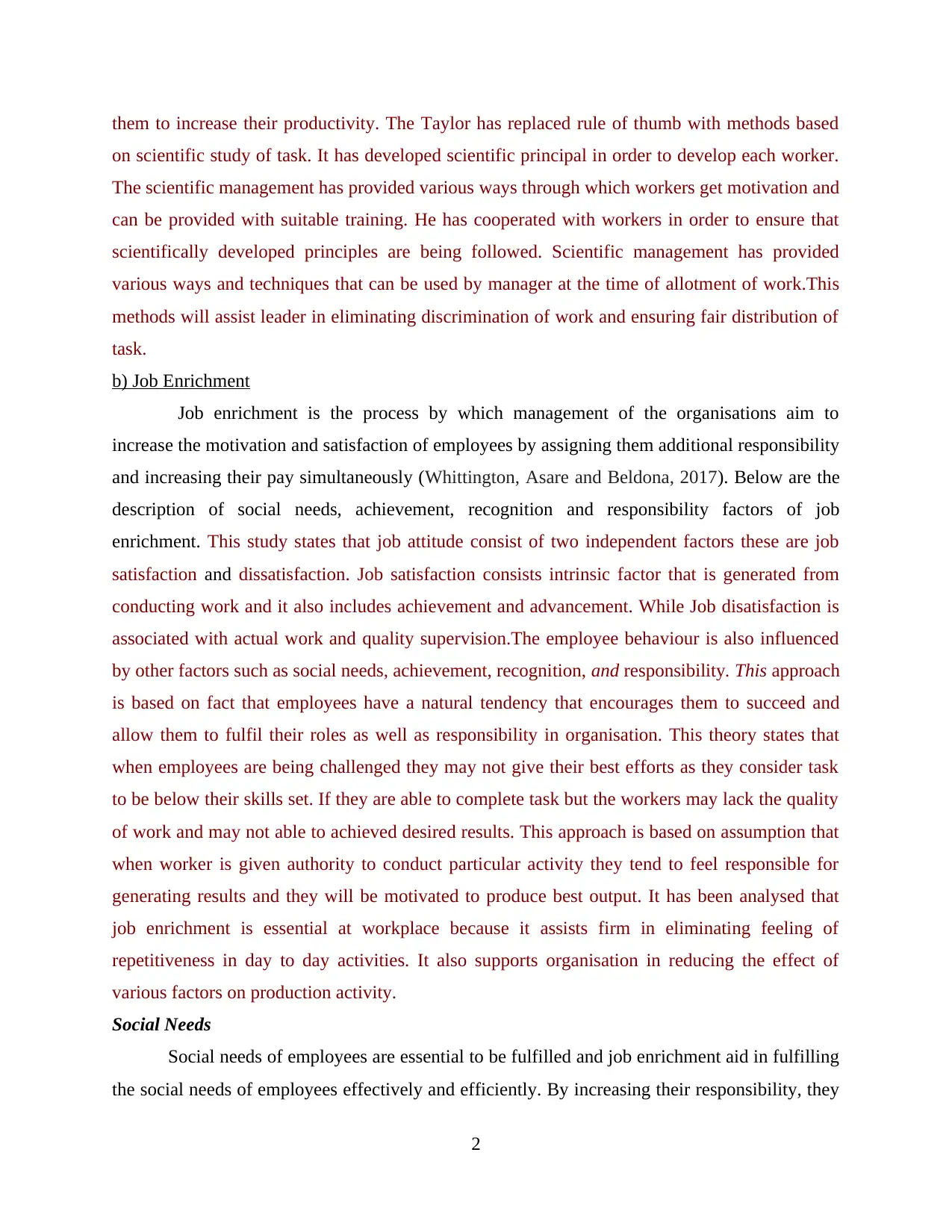
them to increase their productivity. The Taylor has replaced rule of thumb with methods based
on scientific study of task. It has developed scientific principal in order to develop each worker.
The scientific management has provided various ways through which workers get motivation and
can be provided with suitable training. He has cooperated with workers in order to ensure that
scientifically developed principles are being followed. Scientific management has provided
various ways and techniques that can be used by manager at the time of allotment of work.This
methods will assist leader in eliminating discrimination of work and ensuring fair distribution of
task.
b) Job Enrichment
Job enrichment is the process by which management of the organisations aim to
increase the motivation and satisfaction of employees by assigning them additional responsibility
and increasing their pay simultaneously (Whittington, Asare and Beldona, 2017). Below are the
description of social needs, achievement, recognition and responsibility factors of job
enrichment. This study states that job attitude consist of two independent factors these are job
satisfaction and dissatisfaction. Job satisfaction consists intrinsic factor that is generated from
conducting work and it also includes achievement and advancement. While Job disatisfaction is
associated with actual work and quality supervision.The employee behaviour is also influenced
by other factors such as social needs, achievement, recognition, and responsibility. This approach
is based on fact that employees have a natural tendency that encourages them to succeed and
allow them to fulfil their roles as well as responsibility in organisation. This theory states that
when employees are being challenged they may not give their best efforts as they consider task
to be below their skills set. If they are able to complete task but the workers may lack the quality
of work and may not able to achieved desired results. This approach is based on assumption that
when worker is given authority to conduct particular activity they tend to feel responsible for
generating results and they will be motivated to produce best output. It has been analysed that
job enrichment is essential at workplace because it assists firm in eliminating feeling of
repetitiveness in day to day activities. It also supports organisation in reducing the effect of
various factors on production activity.
Social Needs
Social needs of employees are essential to be fulfilled and job enrichment aid in fulfilling
the social needs of employees effectively and efficiently. By increasing their responsibility, they
2
on scientific study of task. It has developed scientific principal in order to develop each worker.
The scientific management has provided various ways through which workers get motivation and
can be provided with suitable training. He has cooperated with workers in order to ensure that
scientifically developed principles are being followed. Scientific management has provided
various ways and techniques that can be used by manager at the time of allotment of work.This
methods will assist leader in eliminating discrimination of work and ensuring fair distribution of
task.
b) Job Enrichment
Job enrichment is the process by which management of the organisations aim to
increase the motivation and satisfaction of employees by assigning them additional responsibility
and increasing their pay simultaneously (Whittington, Asare and Beldona, 2017). Below are the
description of social needs, achievement, recognition and responsibility factors of job
enrichment. This study states that job attitude consist of two independent factors these are job
satisfaction and dissatisfaction. Job satisfaction consists intrinsic factor that is generated from
conducting work and it also includes achievement and advancement. While Job disatisfaction is
associated with actual work and quality supervision.The employee behaviour is also influenced
by other factors such as social needs, achievement, recognition, and responsibility. This approach
is based on fact that employees have a natural tendency that encourages them to succeed and
allow them to fulfil their roles as well as responsibility in organisation. This theory states that
when employees are being challenged they may not give their best efforts as they consider task
to be below their skills set. If they are able to complete task but the workers may lack the quality
of work and may not able to achieved desired results. This approach is based on assumption that
when worker is given authority to conduct particular activity they tend to feel responsible for
generating results and they will be motivated to produce best output. It has been analysed that
job enrichment is essential at workplace because it assists firm in eliminating feeling of
repetitiveness in day to day activities. It also supports organisation in reducing the effect of
various factors on production activity.
Social Needs
Social needs of employees are essential to be fulfilled and job enrichment aid in fulfilling
the social needs of employees effectively and efficiently. By increasing their responsibility, they
2
Secure Best Marks with AI Grader
Need help grading? Try our AI Grader for instant feedback on your assignments.
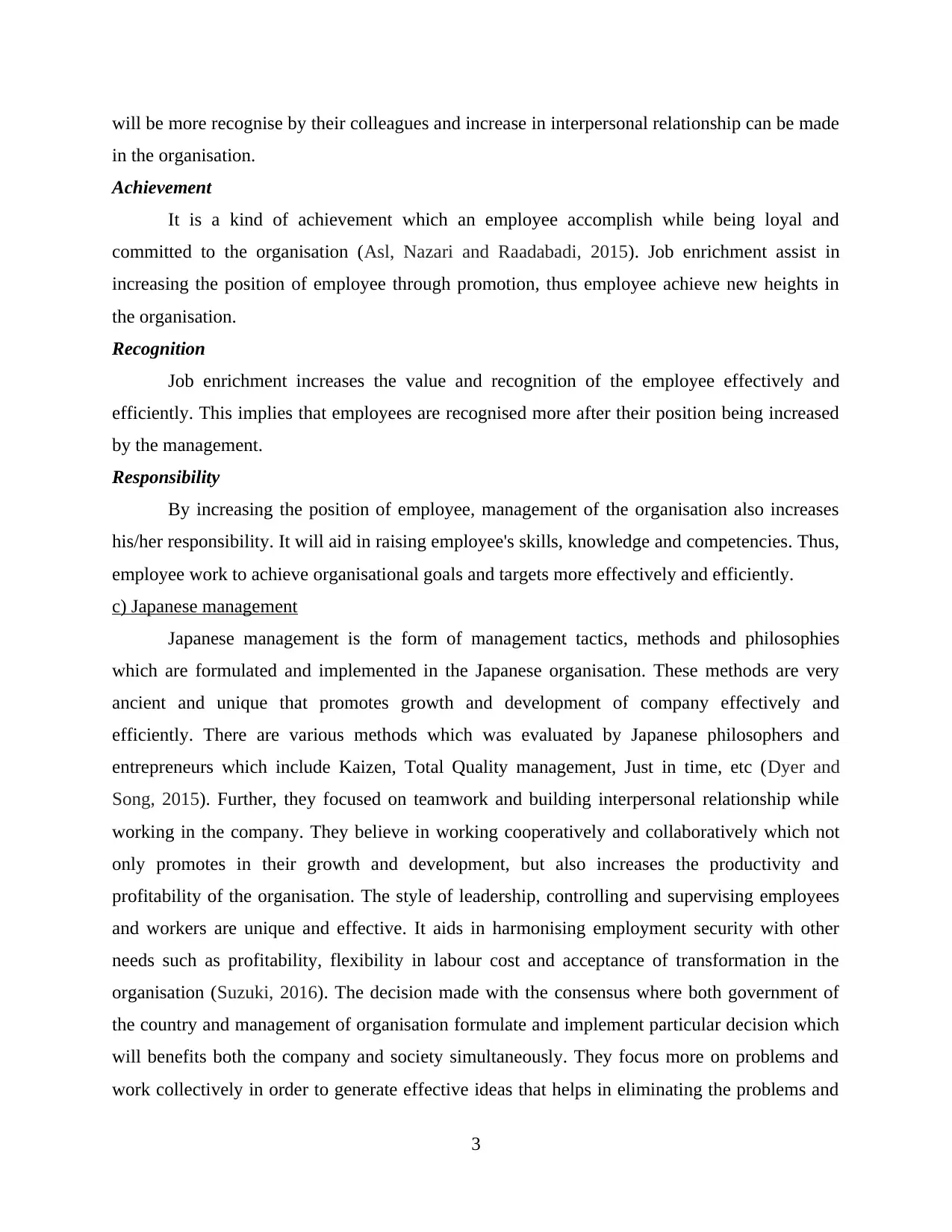
will be more recognise by their colleagues and increase in interpersonal relationship can be made
in the organisation.
Achievement
It is a kind of achievement which an employee accomplish while being loyal and
committed to the organisation (Asl, Nazari and Raadabadi, 2015). Job enrichment assist in
increasing the position of employee through promotion, thus employee achieve new heights in
the organisation.
Recognition
Job enrichment increases the value and recognition of the employee effectively and
efficiently. This implies that employees are recognised more after their position being increased
by the management.
Responsibility
By increasing the position of employee, management of the organisation also increases
his/her responsibility. It will aid in raising employee's skills, knowledge and competencies. Thus,
employee work to achieve organisational goals and targets more effectively and efficiently.
c) Japanese management
Japanese management is the form of management tactics, methods and philosophies
which are formulated and implemented in the Japanese organisation. These methods are very
ancient and unique that promotes growth and development of company effectively and
efficiently. There are various methods which was evaluated by Japanese philosophers and
entrepreneurs which include Kaizen, Total Quality management, Just in time, etc (Dyer and
Song, 2015). Further, they focused on teamwork and building interpersonal relationship while
working in the company. They believe in working cooperatively and collaboratively which not
only promotes in their growth and development, but also increases the productivity and
profitability of the organisation. The style of leadership, controlling and supervising employees
and workers are unique and effective. It aids in harmonising employment security with other
needs such as profitability, flexibility in labour cost and acceptance of transformation in the
organisation (Suzuki, 2016). The decision made with the consensus where both government of
the country and management of organisation formulate and implement particular decision which
will benefits both the company and society simultaneously. They focus more on problems and
work collectively in order to generate effective ideas that helps in eliminating the problems and
3
in the organisation.
Achievement
It is a kind of achievement which an employee accomplish while being loyal and
committed to the organisation (Asl, Nazari and Raadabadi, 2015). Job enrichment assist in
increasing the position of employee through promotion, thus employee achieve new heights in
the organisation.
Recognition
Job enrichment increases the value and recognition of the employee effectively and
efficiently. This implies that employees are recognised more after their position being increased
by the management.
Responsibility
By increasing the position of employee, management of the organisation also increases
his/her responsibility. It will aid in raising employee's skills, knowledge and competencies. Thus,
employee work to achieve organisational goals and targets more effectively and efficiently.
c) Japanese management
Japanese management is the form of management tactics, methods and philosophies
which are formulated and implemented in the Japanese organisation. These methods are very
ancient and unique that promotes growth and development of company effectively and
efficiently. There are various methods which was evaluated by Japanese philosophers and
entrepreneurs which include Kaizen, Total Quality management, Just in time, etc (Dyer and
Song, 2015). Further, they focused on teamwork and building interpersonal relationship while
working in the company. They believe in working cooperatively and collaboratively which not
only promotes in their growth and development, but also increases the productivity and
profitability of the organisation. The style of leadership, controlling and supervising employees
and workers are unique and effective. It aids in harmonising employment security with other
needs such as profitability, flexibility in labour cost and acceptance of transformation in the
organisation (Suzuki, 2016). The decision made with the consensus where both government of
the country and management of organisation formulate and implement particular decision which
will benefits both the company and society simultaneously. They focus more on problems and
work collectively in order to generate effective ideas that helps in eliminating the problems and
3
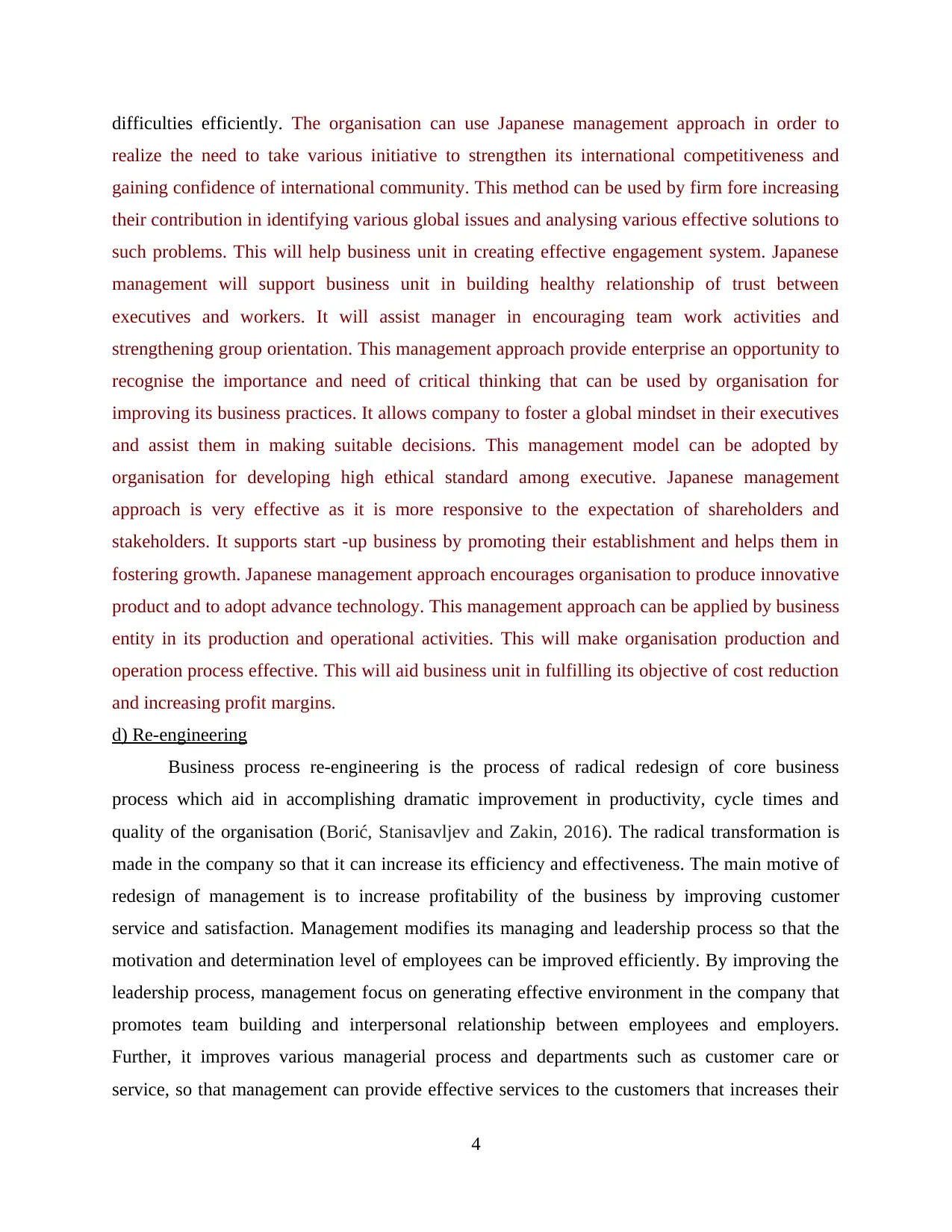
difficulties efficiently. The organisation can use Japanese management approach in order to
realize the need to take various initiative to strengthen its international competitiveness and
gaining confidence of international community. This method can be used by firm fore increasing
their contribution in identifying various global issues and analysing various effective solutions to
such problems. This will help business unit in creating effective engagement system. Japanese
management will support business unit in building healthy relationship of trust between
executives and workers. It will assist manager in encouraging team work activities and
strengthening group orientation. This management approach provide enterprise an opportunity to
recognise the importance and need of critical thinking that can be used by organisation for
improving its business practices. It allows company to foster a global mindset in their executives
and assist them in making suitable decisions. This management model can be adopted by
organisation for developing high ethical standard among executive. Japanese management
approach is very effective as it is more responsive to the expectation of shareholders and
stakeholders. It supports start -up business by promoting their establishment and helps them in
fostering growth. Japanese management approach encourages organisation to produce innovative
product and to adopt advance technology. This management approach can be applied by business
entity in its production and operational activities. This will make organisation production and
operation process effective. This will aid business unit in fulfilling its objective of cost reduction
and increasing profit margins.
d) Re-engineering
Business process re-engineering is the process of radical redesign of core business
process which aid in accomplishing dramatic improvement in productivity, cycle times and
quality of the organisation (Borić, Stanisavljev and Zakin, 2016). The radical transformation is
made in the company so that it can increase its efficiency and effectiveness. The main motive of
redesign of management is to increase profitability of the business by improving customer
service and satisfaction. Management modifies its managing and leadership process so that the
motivation and determination level of employees can be improved efficiently. By improving the
leadership process, management focus on generating effective environment in the company that
promotes team building and interpersonal relationship between employees and employers.
Further, it improves various managerial process and departments such as customer care or
service, so that management can provide effective services to the customers that increases their
4
realize the need to take various initiative to strengthen its international competitiveness and
gaining confidence of international community. This method can be used by firm fore increasing
their contribution in identifying various global issues and analysing various effective solutions to
such problems. This will help business unit in creating effective engagement system. Japanese
management will support business unit in building healthy relationship of trust between
executives and workers. It will assist manager in encouraging team work activities and
strengthening group orientation. This management approach provide enterprise an opportunity to
recognise the importance and need of critical thinking that can be used by organisation for
improving its business practices. It allows company to foster a global mindset in their executives
and assist them in making suitable decisions. This management model can be adopted by
organisation for developing high ethical standard among executive. Japanese management
approach is very effective as it is more responsive to the expectation of shareholders and
stakeholders. It supports start -up business by promoting their establishment and helps them in
fostering growth. Japanese management approach encourages organisation to produce innovative
product and to adopt advance technology. This management approach can be applied by business
entity in its production and operational activities. This will make organisation production and
operation process effective. This will aid business unit in fulfilling its objective of cost reduction
and increasing profit margins.
d) Re-engineering
Business process re-engineering is the process of radical redesign of core business
process which aid in accomplishing dramatic improvement in productivity, cycle times and
quality of the organisation (Borić, Stanisavljev and Zakin, 2016). The radical transformation is
made in the company so that it can increase its efficiency and effectiveness. The main motive of
redesign of management is to increase profitability of the business by improving customer
service and satisfaction. Management modifies its managing and leadership process so that the
motivation and determination level of employees can be improved efficiently. By improving the
leadership process, management focus on generating effective environment in the company that
promotes team building and interpersonal relationship between employees and employers.
Further, it improves various managerial process and departments such as customer care or
service, so that management can provide effective services to the customers that increases their
4
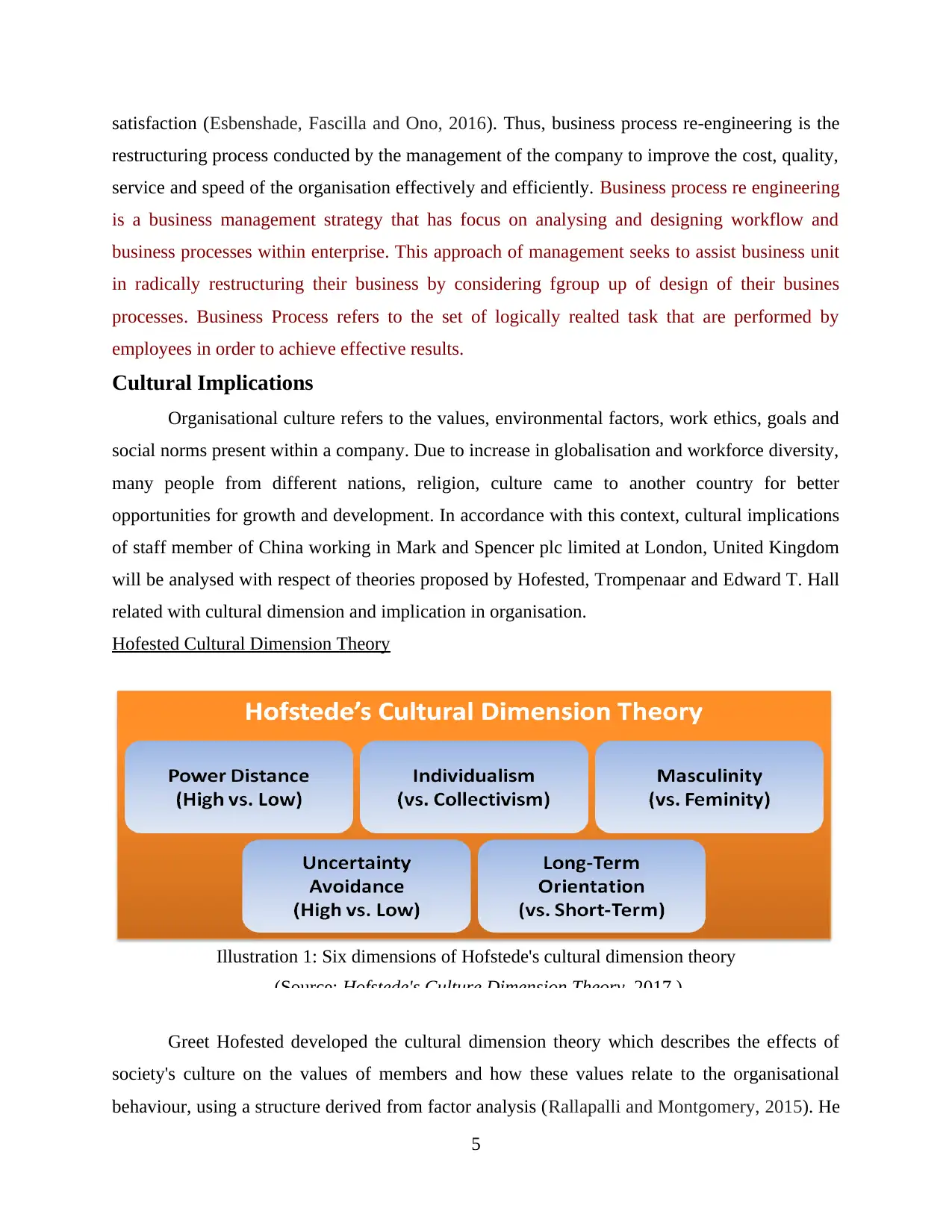
satisfaction (Esbenshade, Fascilla and Ono, 2016). Thus, business process re-engineering is the
restructuring process conducted by the management of the company to improve the cost, quality,
service and speed of the organisation effectively and efficiently. Business process re engineering
is a business management strategy that has focus on analysing and designing workflow and
business processes within enterprise. This approach of management seeks to assist business unit
in radically restructuring their business by considering fgroup up of design of their busines
processes. Business Process refers to the set of logically realted task that are performed by
employees in order to achieve effective results.
Cultural Implications
Organisational culture refers to the values, environmental factors, work ethics, goals and
social norms present within a company. Due to increase in globalisation and workforce diversity,
many people from different nations, religion, culture came to another country for better
opportunities for growth and development. In accordance with this context, cultural implications
of staff member of China working in Mark and Spencer plc limited at London, United Kingdom
will be analysed with respect of theories proposed by Hofested, Trompenaar and Edward T. Hall
related with cultural dimension and implication in organisation.
Hofested Cultural Dimension Theory
Greet Hofested developed the cultural dimension theory which describes the effects of
society's culture on the values of members and how these values relate to the organisational
behaviour, using a structure derived from factor analysis (Rallapalli and Montgomery, 2015). He
5
Illustration 1: Six dimensions of Hofstede's cultural dimension theory
(Source: Hofstede's Culture Dimension Theory, 2017 )
restructuring process conducted by the management of the company to improve the cost, quality,
service and speed of the organisation effectively and efficiently. Business process re engineering
is a business management strategy that has focus on analysing and designing workflow and
business processes within enterprise. This approach of management seeks to assist business unit
in radically restructuring their business by considering fgroup up of design of their busines
processes. Business Process refers to the set of logically realted task that are performed by
employees in order to achieve effective results.
Cultural Implications
Organisational culture refers to the values, environmental factors, work ethics, goals and
social norms present within a company. Due to increase in globalisation and workforce diversity,
many people from different nations, religion, culture came to another country for better
opportunities for growth and development. In accordance with this context, cultural implications
of staff member of China working in Mark and Spencer plc limited at London, United Kingdom
will be analysed with respect of theories proposed by Hofested, Trompenaar and Edward T. Hall
related with cultural dimension and implication in organisation.
Hofested Cultural Dimension Theory
Greet Hofested developed the cultural dimension theory which describes the effects of
society's culture on the values of members and how these values relate to the organisational
behaviour, using a structure derived from factor analysis (Rallapalli and Montgomery, 2015). He
5
Illustration 1: Six dimensions of Hofstede's cultural dimension theory
(Source: Hofstede's Culture Dimension Theory, 2017 )
Paraphrase This Document
Need a fresh take? Get an instant paraphrase of this document with our AI Paraphraser
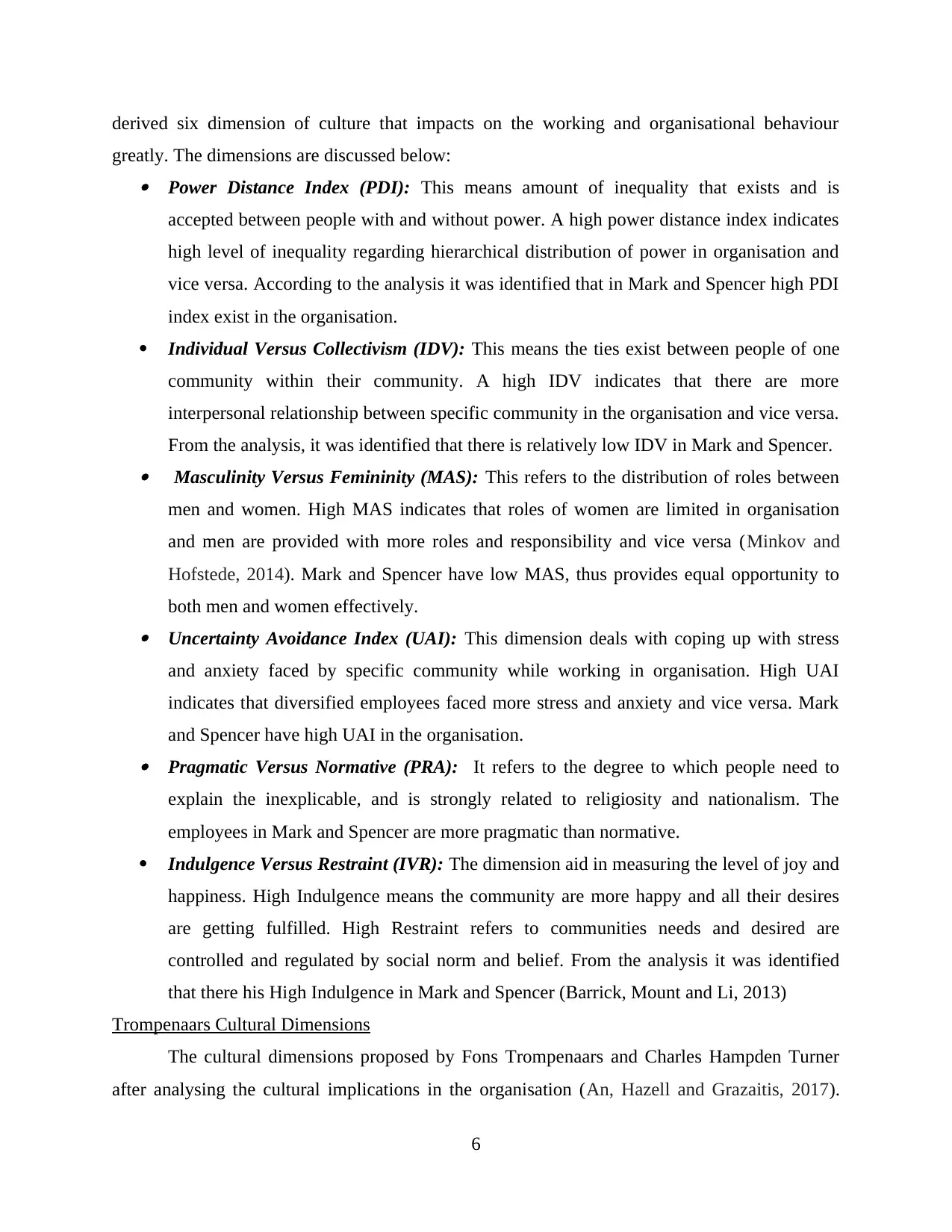
derived six dimension of culture that impacts on the working and organisational behaviour
greatly. The dimensions are discussed below: Power Distance Index (PDI): This means amount of inequality that exists and is
accepted between people with and without power. A high power distance index indicates
high level of inequality regarding hierarchical distribution of power in organisation and
vice versa. According to the analysis it was identified that in Mark and Spencer high PDI
index exist in the organisation.
Individual Versus Collectivism (IDV): This means the ties exist between people of one
community within their community. A high IDV indicates that there are more
interpersonal relationship between specific community in the organisation and vice versa.
From the analysis, it was identified that there is relatively low IDV in Mark and Spencer. Masculinity Versus Femininity (MAS): This refers to the distribution of roles between
men and women. High MAS indicates that roles of women are limited in organisation
and men are provided with more roles and responsibility and vice versa (Minkov and
Hofstede, 2014). Mark and Spencer have low MAS, thus provides equal opportunity to
both men and women effectively. Uncertainty Avoidance Index (UAI): This dimension deals with coping up with stress
and anxiety faced by specific community while working in organisation. High UAI
indicates that diversified employees faced more stress and anxiety and vice versa. Mark
and Spencer have high UAI in the organisation. Pragmatic Versus Normative (PRA): It refers to the degree to which people need to
explain the inexplicable, and is strongly related to religiosity and nationalism. The
employees in Mark and Spencer are more pragmatic than normative.
Indulgence Versus Restraint (IVR): The dimension aid in measuring the level of joy and
happiness. High Indulgence means the community are more happy and all their desires
are getting fulfilled. High Restraint refers to communities needs and desired are
controlled and regulated by social norm and belief. From the analysis it was identified
that there his High Indulgence in Mark and Spencer (Barrick, Mount and Li, 2013)
Trompenaars Cultural Dimensions
The cultural dimensions proposed by Fons Trompenaars and Charles Hampden Turner
after analysing the cultural implications in the organisation (An, Hazell and Grazaitis, 2017).
6
greatly. The dimensions are discussed below: Power Distance Index (PDI): This means amount of inequality that exists and is
accepted between people with and without power. A high power distance index indicates
high level of inequality regarding hierarchical distribution of power in organisation and
vice versa. According to the analysis it was identified that in Mark and Spencer high PDI
index exist in the organisation.
Individual Versus Collectivism (IDV): This means the ties exist between people of one
community within their community. A high IDV indicates that there are more
interpersonal relationship between specific community in the organisation and vice versa.
From the analysis, it was identified that there is relatively low IDV in Mark and Spencer. Masculinity Versus Femininity (MAS): This refers to the distribution of roles between
men and women. High MAS indicates that roles of women are limited in organisation
and men are provided with more roles and responsibility and vice versa (Minkov and
Hofstede, 2014). Mark and Spencer have low MAS, thus provides equal opportunity to
both men and women effectively. Uncertainty Avoidance Index (UAI): This dimension deals with coping up with stress
and anxiety faced by specific community while working in organisation. High UAI
indicates that diversified employees faced more stress and anxiety and vice versa. Mark
and Spencer have high UAI in the organisation. Pragmatic Versus Normative (PRA): It refers to the degree to which people need to
explain the inexplicable, and is strongly related to religiosity and nationalism. The
employees in Mark and Spencer are more pragmatic than normative.
Indulgence Versus Restraint (IVR): The dimension aid in measuring the level of joy and
happiness. High Indulgence means the community are more happy and all their desires
are getting fulfilled. High Restraint refers to communities needs and desired are
controlled and regulated by social norm and belief. From the analysis it was identified
that there his High Indulgence in Mark and Spencer (Barrick, Mount and Li, 2013)
Trompenaars Cultural Dimensions
The cultural dimensions proposed by Fons Trompenaars and Charles Hampden Turner
after analysing the cultural implications in the organisation (An, Hazell and Grazaitis, 2017).
6
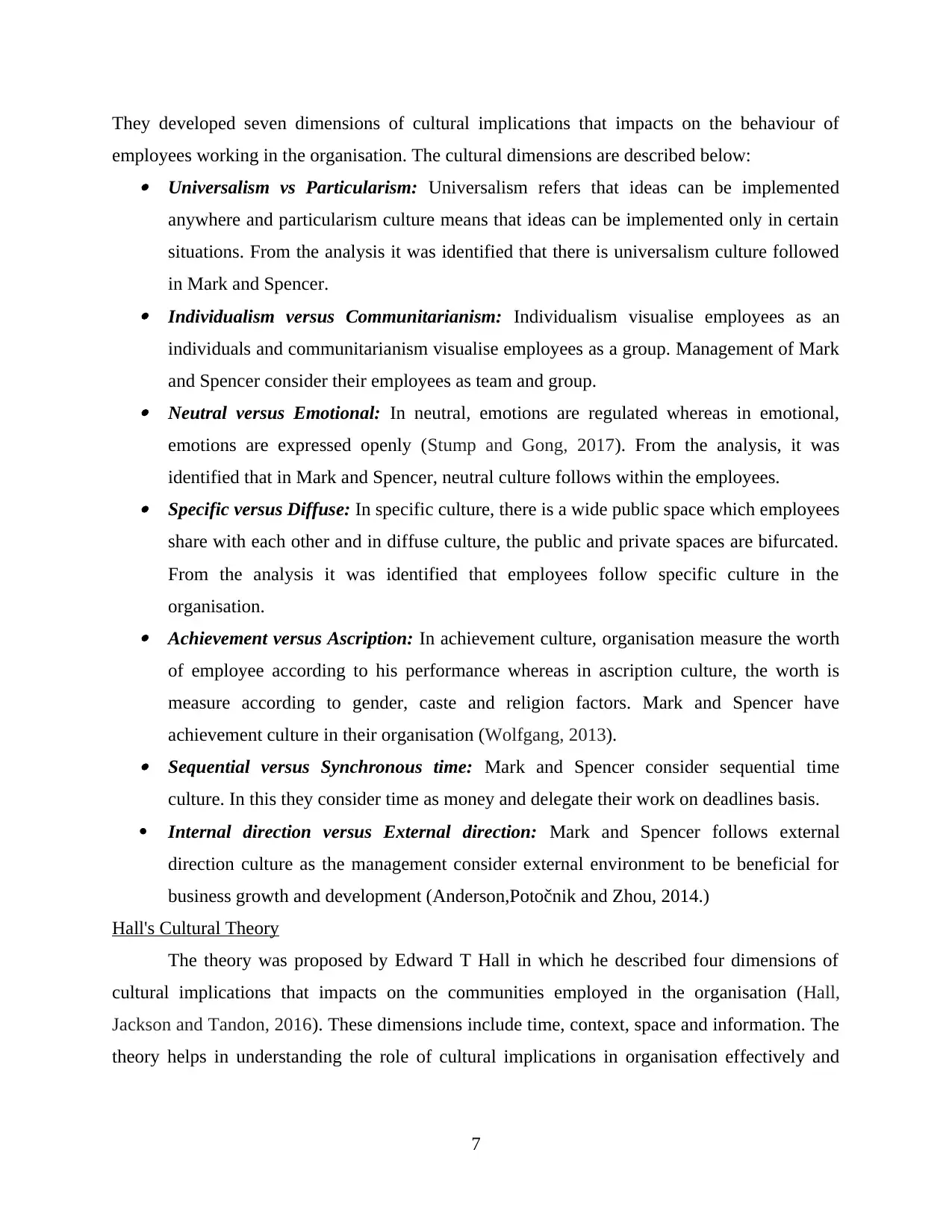
They developed seven dimensions of cultural implications that impacts on the behaviour of
employees working in the organisation. The cultural dimensions are described below: Universalism vs Particularism: Universalism refers that ideas can be implemented
anywhere and particularism culture means that ideas can be implemented only in certain
situations. From the analysis it was identified that there is universalism culture followed
in Mark and Spencer. Individualism versus Communitarianism: Individualism visualise employees as an
individuals and communitarianism visualise employees as a group. Management of Mark
and Spencer consider their employees as team and group. Neutral versus Emotional: In neutral, emotions are regulated whereas in emotional,
emotions are expressed openly (Stump and Gong, 2017). From the analysis, it was
identified that in Mark and Spencer, neutral culture follows within the employees. Specific versus Diffuse: In specific culture, there is a wide public space which employees
share with each other and in diffuse culture, the public and private spaces are bifurcated.
From the analysis it was identified that employees follow specific culture in the
organisation. Achievement versus Ascription: In achievement culture, organisation measure the worth
of employee according to his performance whereas in ascription culture, the worth is
measure according to gender, caste and religion factors. Mark and Spencer have
achievement culture in their organisation (Wolfgang, 2013). Sequential versus Synchronous time: Mark and Spencer consider sequential time
culture. In this they consider time as money and delegate their work on deadlines basis.
Internal direction versus External direction: Mark and Spencer follows external
direction culture as the management consider external environment to be beneficial for
business growth and development (Anderson,Potočnik and Zhou, 2014.)
Hall's Cultural Theory
The theory was proposed by Edward T Hall in which he described four dimensions of
cultural implications that impacts on the communities employed in the organisation (Hall,
Jackson and Tandon, 2016). These dimensions include time, context, space and information. The
theory helps in understanding the role of cultural implications in organisation effectively and
7
employees working in the organisation. The cultural dimensions are described below: Universalism vs Particularism: Universalism refers that ideas can be implemented
anywhere and particularism culture means that ideas can be implemented only in certain
situations. From the analysis it was identified that there is universalism culture followed
in Mark and Spencer. Individualism versus Communitarianism: Individualism visualise employees as an
individuals and communitarianism visualise employees as a group. Management of Mark
and Spencer consider their employees as team and group. Neutral versus Emotional: In neutral, emotions are regulated whereas in emotional,
emotions are expressed openly (Stump and Gong, 2017). From the analysis, it was
identified that in Mark and Spencer, neutral culture follows within the employees. Specific versus Diffuse: In specific culture, there is a wide public space which employees
share with each other and in diffuse culture, the public and private spaces are bifurcated.
From the analysis it was identified that employees follow specific culture in the
organisation. Achievement versus Ascription: In achievement culture, organisation measure the worth
of employee according to his performance whereas in ascription culture, the worth is
measure according to gender, caste and religion factors. Mark and Spencer have
achievement culture in their organisation (Wolfgang, 2013). Sequential versus Synchronous time: Mark and Spencer consider sequential time
culture. In this they consider time as money and delegate their work on deadlines basis.
Internal direction versus External direction: Mark and Spencer follows external
direction culture as the management consider external environment to be beneficial for
business growth and development (Anderson,Potočnik and Zhou, 2014.)
Hall's Cultural Theory
The theory was proposed by Edward T Hall in which he described four dimensions of
cultural implications that impacts on the communities employed in the organisation (Hall,
Jackson and Tandon, 2016). These dimensions include time, context, space and information. The
theory helps in understanding the role of cultural implications in organisation effectively and
7
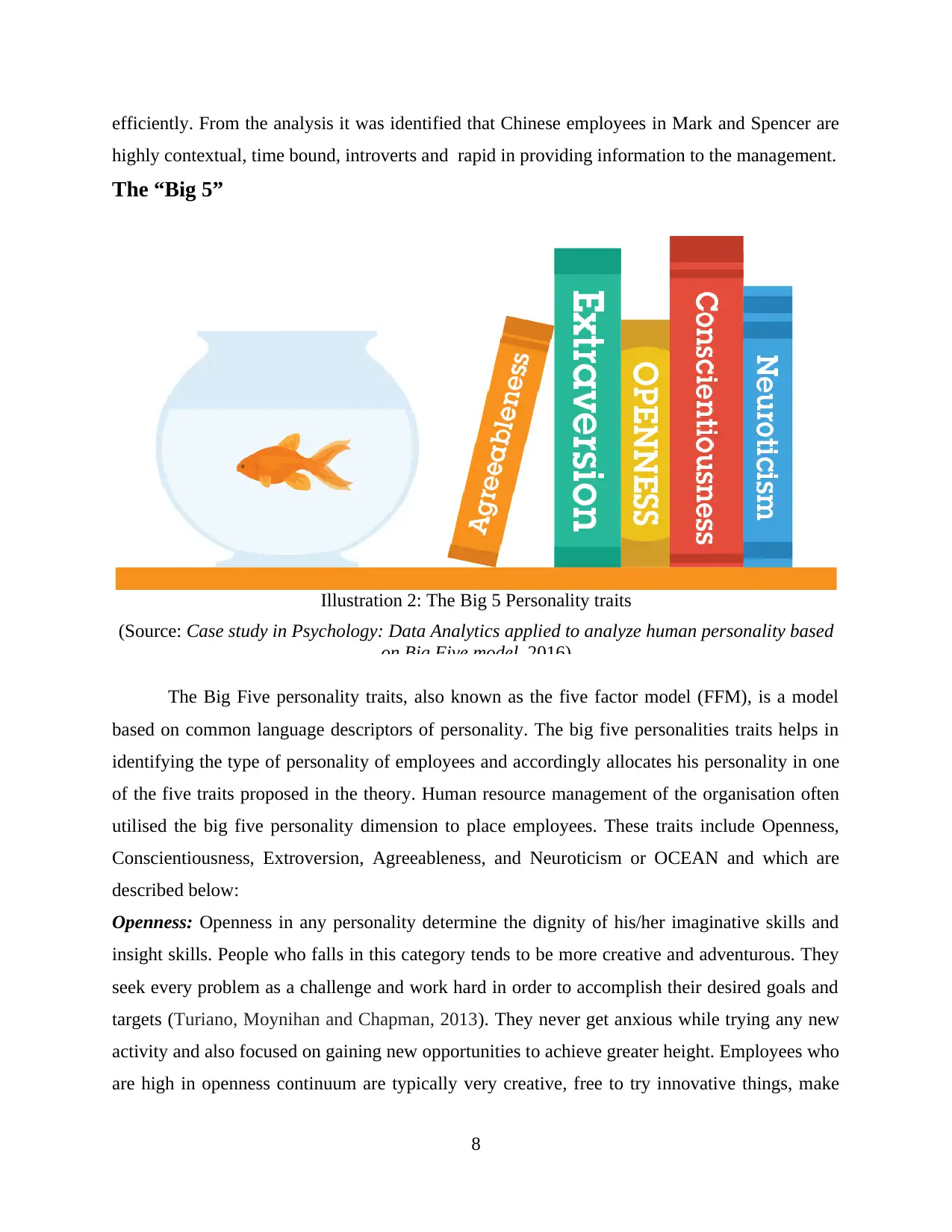
efficiently. From the analysis it was identified that Chinese employees in Mark and Spencer are
highly contextual, time bound, introverts and rapid in providing information to the management.
The “Big 5”
The Big Five personality traits, also known as the five factor model (FFM), is a model
based on common language descriptors of personality. The big five personalities traits helps in
identifying the type of personality of employees and accordingly allocates his personality in one
of the five traits proposed in the theory. Human resource management of the organisation often
utilised the big five personality dimension to place employees. These traits include Openness,
Conscientiousness, Extroversion, Agreeableness, and Neuroticism or OCEAN and which are
described below:
Openness: Openness in any personality determine the dignity of his/her imaginative skills and
insight skills. People who falls in this category tends to be more creative and adventurous. They
seek every problem as a challenge and work hard in order to accomplish their desired goals and
targets (Turiano, Moynihan and Chapman, 2013). They never get anxious while trying any new
activity and also focused on gaining new opportunities to achieve greater height. Employees who
are high in openness continuum are typically very creative, free to try innovative things, make
8
Illustration 2: The Big 5 Personality traits
(Source: Case study in Psychology: Data Analytics applied to analyze human personality based
on Big Five model, 2016)
highly contextual, time bound, introverts and rapid in providing information to the management.
The “Big 5”
The Big Five personality traits, also known as the five factor model (FFM), is a model
based on common language descriptors of personality. The big five personalities traits helps in
identifying the type of personality of employees and accordingly allocates his personality in one
of the five traits proposed in the theory. Human resource management of the organisation often
utilised the big five personality dimension to place employees. These traits include Openness,
Conscientiousness, Extroversion, Agreeableness, and Neuroticism or OCEAN and which are
described below:
Openness: Openness in any personality determine the dignity of his/her imaginative skills and
insight skills. People who falls in this category tends to be more creative and adventurous. They
seek every problem as a challenge and work hard in order to accomplish their desired goals and
targets (Turiano, Moynihan and Chapman, 2013). They never get anxious while trying any new
activity and also focused on gaining new opportunities to achieve greater height. Employees who
are high in openness continuum are typically very creative, free to try innovative things, make
8
Illustration 2: The Big 5 Personality traits
(Source: Case study in Psychology: Data Analytics applied to analyze human personality based
on Big Five model, 2016)
Secure Best Marks with AI Grader
Need help grading? Try our AI Grader for instant feedback on your assignments.
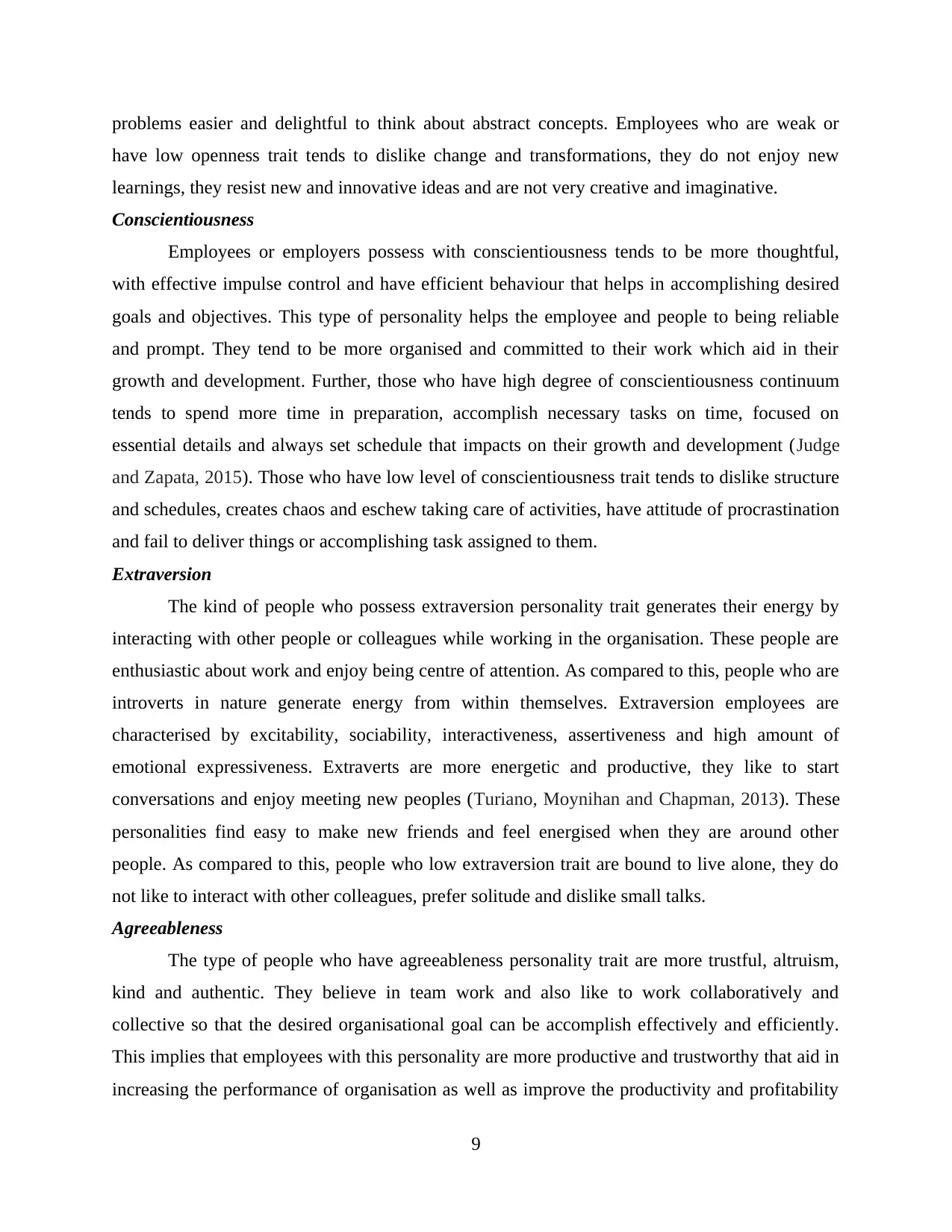
problems easier and delightful to think about abstract concepts. Employees who are weak or
have low openness trait tends to dislike change and transformations, they do not enjoy new
learnings, they resist new and innovative ideas and are not very creative and imaginative.
Conscientiousness
Employees or employers possess with conscientiousness tends to be more thoughtful,
with effective impulse control and have efficient behaviour that helps in accomplishing desired
goals and objectives. This type of personality helps the employee and people to being reliable
and prompt. They tend to be more organised and committed to their work which aid in their
growth and development. Further, those who have high degree of conscientiousness continuum
tends to spend more time in preparation, accomplish necessary tasks on time, focused on
essential details and always set schedule that impacts on their growth and development (Judge
and Zapata, 2015). Those who have low level of conscientiousness trait tends to dislike structure
and schedules, creates chaos and eschew taking care of activities, have attitude of procrastination
and fail to deliver things or accomplishing task assigned to them.
Extraversion
The kind of people who possess extraversion personality trait generates their energy by
interacting with other people or colleagues while working in the organisation. These people are
enthusiastic about work and enjoy being centre of attention. As compared to this, people who are
introverts in nature generate energy from within themselves. Extraversion employees are
characterised by excitability, sociability, interactiveness, assertiveness and high amount of
emotional expressiveness. Extraverts are more energetic and productive, they like to start
conversations and enjoy meeting new peoples (Turiano, Moynihan and Chapman, 2013). These
personalities find easy to make new friends and feel energised when they are around other
people. As compared to this, people who low extraversion trait are bound to live alone, they do
not like to interact with other colleagues, prefer solitude and dislike small talks.
Agreeableness
The type of people who have agreeableness personality trait are more trustful, altruism,
kind and authentic. They believe in team work and also like to work collaboratively and
collective so that the desired organisational goal can be accomplish effectively and efficiently.
This implies that employees with this personality are more productive and trustworthy that aid in
increasing the performance of organisation as well as improve the productivity and profitability
9
have low openness trait tends to dislike change and transformations, they do not enjoy new
learnings, they resist new and innovative ideas and are not very creative and imaginative.
Conscientiousness
Employees or employers possess with conscientiousness tends to be more thoughtful,
with effective impulse control and have efficient behaviour that helps in accomplishing desired
goals and objectives. This type of personality helps the employee and people to being reliable
and prompt. They tend to be more organised and committed to their work which aid in their
growth and development. Further, those who have high degree of conscientiousness continuum
tends to spend more time in preparation, accomplish necessary tasks on time, focused on
essential details and always set schedule that impacts on their growth and development (Judge
and Zapata, 2015). Those who have low level of conscientiousness trait tends to dislike structure
and schedules, creates chaos and eschew taking care of activities, have attitude of procrastination
and fail to deliver things or accomplishing task assigned to them.
Extraversion
The kind of people who possess extraversion personality trait generates their energy by
interacting with other people or colleagues while working in the organisation. These people are
enthusiastic about work and enjoy being centre of attention. As compared to this, people who are
introverts in nature generate energy from within themselves. Extraversion employees are
characterised by excitability, sociability, interactiveness, assertiveness and high amount of
emotional expressiveness. Extraverts are more energetic and productive, they like to start
conversations and enjoy meeting new peoples (Turiano, Moynihan and Chapman, 2013). These
personalities find easy to make new friends and feel energised when they are around other
people. As compared to this, people who low extraversion trait are bound to live alone, they do
not like to interact with other colleagues, prefer solitude and dislike small talks.
Agreeableness
The type of people who have agreeableness personality trait are more trustful, altruism,
kind and authentic. They believe in team work and also like to work collaboratively and
collective so that the desired organisational goal can be accomplish effectively and efficiently.
This implies that employees with this personality are more productive and trustworthy that aid in
increasing the performance of organisation as well as improve the productivity and profitability
9
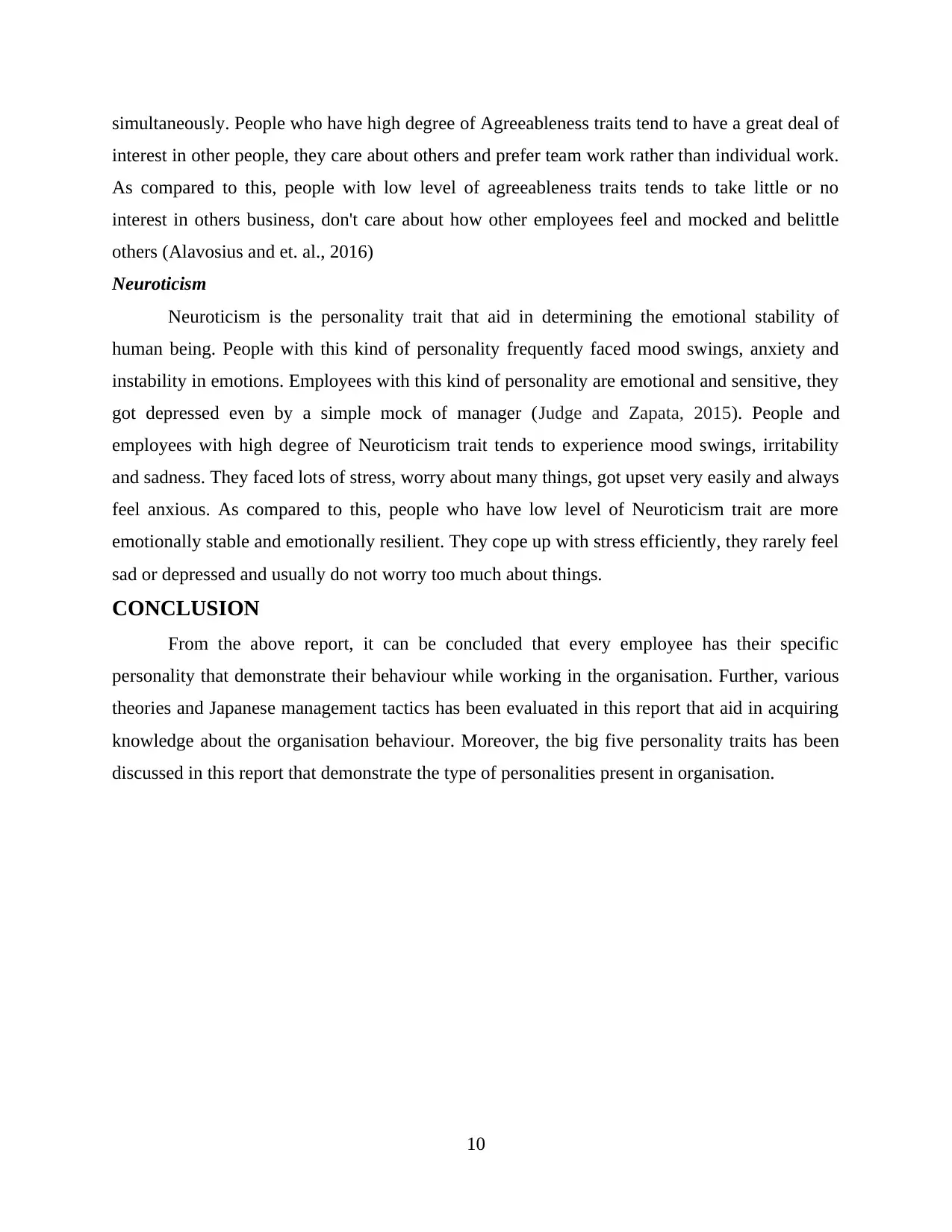
simultaneously. People who have high degree of Agreeableness traits tend to have a great deal of
interest in other people, they care about others and prefer team work rather than individual work.
As compared to this, people with low level of agreeableness traits tends to take little or no
interest in others business, don't care about how other employees feel and mocked and belittle
others (Alavosius and et. al., 2016)
Neuroticism
Neuroticism is the personality trait that aid in determining the emotional stability of
human being. People with this kind of personality frequently faced mood swings, anxiety and
instability in emotions. Employees with this kind of personality are emotional and sensitive, they
got depressed even by a simple mock of manager (Judge and Zapata, 2015). People and
employees with high degree of Neuroticism trait tends to experience mood swings, irritability
and sadness. They faced lots of stress, worry about many things, got upset very easily and always
feel anxious. As compared to this, people who have low level of Neuroticism trait are more
emotionally stable and emotionally resilient. They cope up with stress efficiently, they rarely feel
sad or depressed and usually do not worry too much about things.
CONCLUSION
From the above report, it can be concluded that every employee has their specific
personality that demonstrate their behaviour while working in the organisation. Further, various
theories and Japanese management tactics has been evaluated in this report that aid in acquiring
knowledge about the organisation behaviour. Moreover, the big five personality traits has been
discussed in this report that demonstrate the type of personalities present in organisation.
10
interest in other people, they care about others and prefer team work rather than individual work.
As compared to this, people with low level of agreeableness traits tends to take little or no
interest in others business, don't care about how other employees feel and mocked and belittle
others (Alavosius and et. al., 2016)
Neuroticism
Neuroticism is the personality trait that aid in determining the emotional stability of
human being. People with this kind of personality frequently faced mood swings, anxiety and
instability in emotions. Employees with this kind of personality are emotional and sensitive, they
got depressed even by a simple mock of manager (Judge and Zapata, 2015). People and
employees with high degree of Neuroticism trait tends to experience mood swings, irritability
and sadness. They faced lots of stress, worry about many things, got upset very easily and always
feel anxious. As compared to this, people who have low level of Neuroticism trait are more
emotionally stable and emotionally resilient. They cope up with stress efficiently, they rarely feel
sad or depressed and usually do not worry too much about things.
CONCLUSION
From the above report, it can be concluded that every employee has their specific
personality that demonstrate their behaviour while working in the organisation. Further, various
theories and Japanese management tactics has been evaluated in this report that aid in acquiring
knowledge about the organisation behaviour. Moreover, the big five personality traits has been
discussed in this report that demonstrate the type of personalities present in organisation.
10
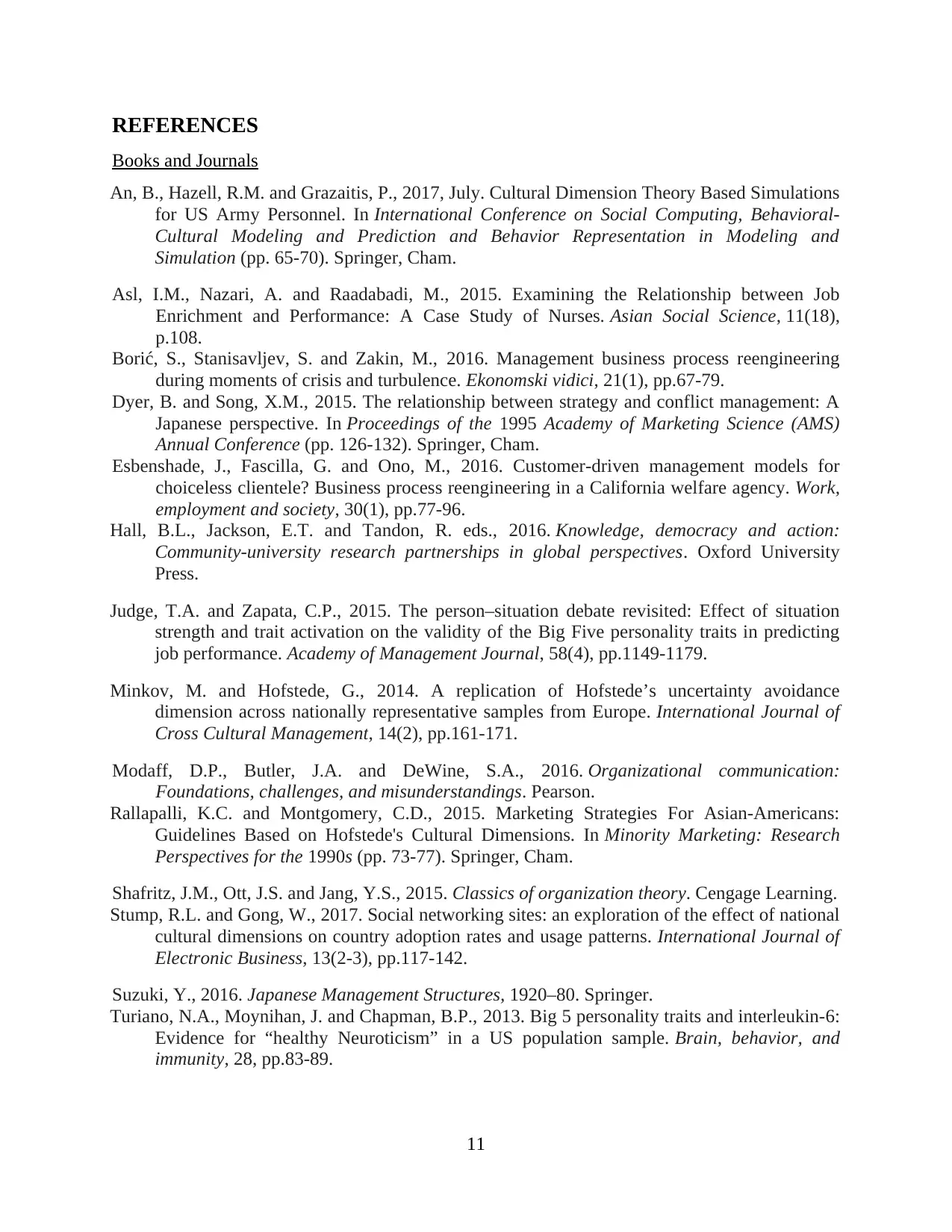
REFERENCES
Books and Journals
An, B., Hazell, R.M. and Grazaitis, P., 2017, July. Cultural Dimension Theory Based Simulations
for US Army Personnel. In International Conference on Social Computing, Behavioral-
Cultural Modeling and Prediction and Behavior Representation in Modeling and
Simulation (pp. 65-70). Springer, Cham.
Asl, I.M., Nazari, A. and Raadabadi, M., 2015. Examining the Relationship between Job
Enrichment and Performance: A Case Study of Nurses. Asian Social Science, 11(18),
p.108.
Borić, S., Stanisavljev, S. and Zakin, M., 2016. Management business process reengineering
during moments of crisis and turbulence. Ekonomski vidici, 21(1), pp.67-79.
Dyer, B. and Song, X.M., 2015. The relationship between strategy and conflict management: A
Japanese perspective. In Proceedings of the 1995 Academy of Marketing Science (AMS)
Annual Conference (pp. 126-132). Springer, Cham.
Esbenshade, J., Fascilla, G. and Ono, M., 2016. Customer-driven management models for
choiceless clientele? Business process reengineering in a California welfare agency. Work,
employment and society, 30(1), pp.77-96.
Hall, B.L., Jackson, E.T. and Tandon, R. eds., 2016. Knowledge, democracy and action:
Community-university research partnerships in global perspectives. Oxford University
Press.
Judge, T.A. and Zapata, C.P., 2015. The person–situation debate revisited: Effect of situation
strength and trait activation on the validity of the Big Five personality traits in predicting
job performance. Academy of Management Journal, 58(4), pp.1149-1179.
Minkov, M. and Hofstede, G., 2014. A replication of Hofstede’s uncertainty avoidance
dimension across nationally representative samples from Europe. International Journal of
Cross Cultural Management, 14(2), pp.161-171.
Modaff, D.P., Butler, J.A. and DeWine, S.A., 2016. Organizational communication:
Foundations, challenges, and misunderstandings. Pearson.
Rallapalli, K.C. and Montgomery, C.D., 2015. Marketing Strategies For Asian-Americans:
Guidelines Based on Hofstede's Cultural Dimensions. In Minority Marketing: Research
Perspectives for the 1990s (pp. 73-77). Springer, Cham.
Shafritz, J.M., Ott, J.S. and Jang, Y.S., 2015. Classics of organization theory. Cengage Learning.
Stump, R.L. and Gong, W., 2017. Social networking sites: an exploration of the effect of national
cultural dimensions on country adoption rates and usage patterns. International Journal of
Electronic Business, 13(2-3), pp.117-142.
Suzuki, Y., 2016. Japanese Management Structures, 1920–80. Springer.
Turiano, N.A., Moynihan, J. and Chapman, B.P., 2013. Big 5 personality traits and interleukin-6:
Evidence for “healthy Neuroticism” in a US population sample. Brain, behavior, and
immunity, 28, pp.83-89.
11
Books and Journals
An, B., Hazell, R.M. and Grazaitis, P., 2017, July. Cultural Dimension Theory Based Simulations
for US Army Personnel. In International Conference on Social Computing, Behavioral-
Cultural Modeling and Prediction and Behavior Representation in Modeling and
Simulation (pp. 65-70). Springer, Cham.
Asl, I.M., Nazari, A. and Raadabadi, M., 2015. Examining the Relationship between Job
Enrichment and Performance: A Case Study of Nurses. Asian Social Science, 11(18),
p.108.
Borić, S., Stanisavljev, S. and Zakin, M., 2016. Management business process reengineering
during moments of crisis and turbulence. Ekonomski vidici, 21(1), pp.67-79.
Dyer, B. and Song, X.M., 2015. The relationship between strategy and conflict management: A
Japanese perspective. In Proceedings of the 1995 Academy of Marketing Science (AMS)
Annual Conference (pp. 126-132). Springer, Cham.
Esbenshade, J., Fascilla, G. and Ono, M., 2016. Customer-driven management models for
choiceless clientele? Business process reengineering in a California welfare agency. Work,
employment and society, 30(1), pp.77-96.
Hall, B.L., Jackson, E.T. and Tandon, R. eds., 2016. Knowledge, democracy and action:
Community-university research partnerships in global perspectives. Oxford University
Press.
Judge, T.A. and Zapata, C.P., 2015. The person–situation debate revisited: Effect of situation
strength and trait activation on the validity of the Big Five personality traits in predicting
job performance. Academy of Management Journal, 58(4), pp.1149-1179.
Minkov, M. and Hofstede, G., 2014. A replication of Hofstede’s uncertainty avoidance
dimension across nationally representative samples from Europe. International Journal of
Cross Cultural Management, 14(2), pp.161-171.
Modaff, D.P., Butler, J.A. and DeWine, S.A., 2016. Organizational communication:
Foundations, challenges, and misunderstandings. Pearson.
Rallapalli, K.C. and Montgomery, C.D., 2015. Marketing Strategies For Asian-Americans:
Guidelines Based on Hofstede's Cultural Dimensions. In Minority Marketing: Research
Perspectives for the 1990s (pp. 73-77). Springer, Cham.
Shafritz, J.M., Ott, J.S. and Jang, Y.S., 2015. Classics of organization theory. Cengage Learning.
Stump, R.L. and Gong, W., 2017. Social networking sites: an exploration of the effect of national
cultural dimensions on country adoption rates and usage patterns. International Journal of
Electronic Business, 13(2-3), pp.117-142.
Suzuki, Y., 2016. Japanese Management Structures, 1920–80. Springer.
Turiano, N.A., Moynihan, J. and Chapman, B.P., 2013. Big 5 personality traits and interleukin-6:
Evidence for “healthy Neuroticism” in a US population sample. Brain, behavior, and
immunity, 28, pp.83-89.
11
Paraphrase This Document
Need a fresh take? Get an instant paraphrase of this document with our AI Paraphraser
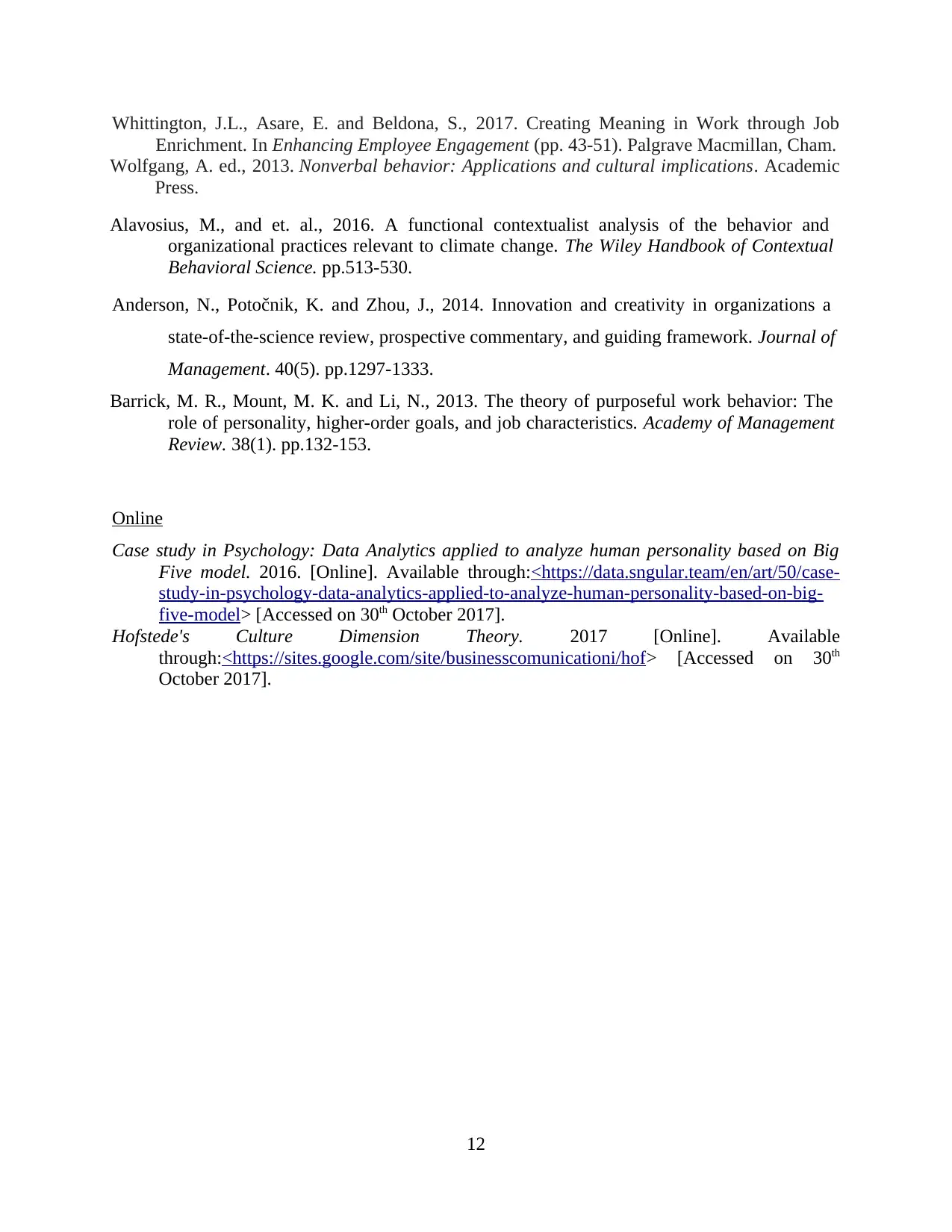
Whittington, J.L., Asare, E. and Beldona, S., 2017. Creating Meaning in Work through Job
Enrichment. In Enhancing Employee Engagement (pp. 43-51). Palgrave Macmillan, Cham.
Wolfgang, A. ed., 2013. Nonverbal behavior: Applications and cultural implications. Academic
Press.
Alavosius, M., and et. al., 2016. A functional contextualist analysis of the behavior and
organizational practices relevant to climate change. The Wiley Handbook of Contextual
Behavioral Science. pp.513-530.
Anderson, N., Potočnik, K. and Zhou, J., 2014. Innovation and creativity in organizations a
state-of-the-science review, prospective commentary, and guiding framework. Journal of
Management. 40(5). pp.1297-1333.
Barrick, M. R., Mount, M. K. and Li, N., 2013. The theory of purposeful work behavior: The
role of personality, higher-order goals, and job characteristics. Academy of Management
Review. 38(1). pp.132-153.
Online
Case study in Psychology: Data Analytics applied to analyze human personality based on Big
Five model. 2016. [Online]. Available through:<https://data.sngular.team/en/art/50/case-
study-in-psychology-data-analytics-applied-to-analyze-human-personality-based-on-big-
five-model> [Accessed on 30th October 2017].
Hofstede's Culture Dimension Theory. 2017 [Online]. Available
through:<https://sites.google.com/site/businesscomunicationi/hof> [Accessed on 30th
October 2017].
12
Enrichment. In Enhancing Employee Engagement (pp. 43-51). Palgrave Macmillan, Cham.
Wolfgang, A. ed., 2013. Nonverbal behavior: Applications and cultural implications. Academic
Press.
Alavosius, M., and et. al., 2016. A functional contextualist analysis of the behavior and
organizational practices relevant to climate change. The Wiley Handbook of Contextual
Behavioral Science. pp.513-530.
Anderson, N., Potočnik, K. and Zhou, J., 2014. Innovation and creativity in organizations a
state-of-the-science review, prospective commentary, and guiding framework. Journal of
Management. 40(5). pp.1297-1333.
Barrick, M. R., Mount, M. K. and Li, N., 2013. The theory of purposeful work behavior: The
role of personality, higher-order goals, and job characteristics. Academy of Management
Review. 38(1). pp.132-153.
Online
Case study in Psychology: Data Analytics applied to analyze human personality based on Big
Five model. 2016. [Online]. Available through:<https://data.sngular.team/en/art/50/case-
study-in-psychology-data-analytics-applied-to-analyze-human-personality-based-on-big-
five-model> [Accessed on 30th October 2017].
Hofstede's Culture Dimension Theory. 2017 [Online]. Available
through:<https://sites.google.com/site/businesscomunicationi/hof> [Accessed on 30th
October 2017].
12
1 out of 14
Related Documents
Your All-in-One AI-Powered Toolkit for Academic Success.
+13062052269
info@desklib.com
Available 24*7 on WhatsApp / Email
![[object Object]](/_next/static/media/star-bottom.7253800d.svg)
Unlock your academic potential
© 2024 | Zucol Services PVT LTD | All rights reserved.





